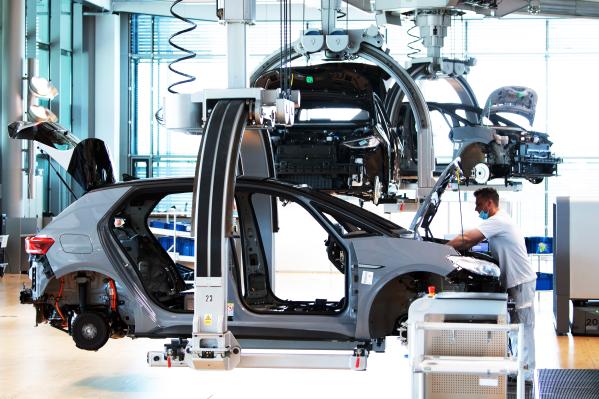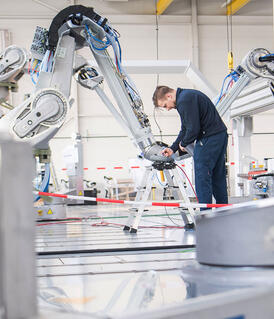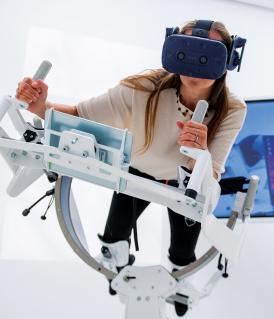How Germany’s industry is shaping the future

Germany’s economic strength is based not only on its SMEs SMEs The German economy is characterized first and foremost by small and medium-sized enterprises as well as the self-employed and the independent professions. Some 99.4 percent of all companies are small and medium-sized enterprises. These are firms with annual sales of below EUR 50 million and a… Read more › , but also on the efficiency and innovative capacity of its industry. Employing around 780,000 people, the automotive industry in particular is seen as a prime example of “made in Germany“.
These six major carmakers from Germany are driving the transition towards green mobility worldwide:
- Volkswagen
- Mercedes-Benz
- BMW
- Audi
- Opel (Stellantis)
- Porsche
Mobility in transition: billions for the future
In order to stay competitive, German businesses are investing billions in research and development (R&D). Electric motors, digital networks and assisted or even autonomous driving are megatrends in automotive transportation. Roughly two thirds of cars made by German manufacturers are produced in factories abroad.
Which German companies are setting standards worldwide?
Traditionally strong branches of the German economy also include the global corporations of the chemicals industry, as well as plant and mechanical engineering firms. Established in 1865 and headquartered in Ludwigshafen, BASF employs around 112,000 people at its 235 production sites in 92 countries, making it the world’s largest chemicals company.
The leading German plant and mechanical engineering firm is also a global leader in the key sector of electrical engineering and electronics: Siemens is a global player operating in more than 190 countries that offers highly innovative applied solutions - from mobility to renewable energies.
Where are Germany’s leading economic centres situated?
The leading economic centres in Germany are its big metropolitan regions, which include:
- the Ruhr region
- the greater Munich and Stuttgart areas (high tech, automotive engineering)
- Rhine-Neckar (chemicals, IT)
- Frankfurt am Main (finance)
- Nuremberg (industry, services)
- Cologne (media)
- Hamburg Hamburg In the city and state of Hamburg it is the port that is the power-house of the economy, though with Airbus, Otto Versand and Beiersdorf also located here, this is not immediately apparent. The tanker terminals, mean that almost all the major oil-refining companies are represented in the port. For… Read more › (port, aircraft construction)
In the east of Germany, leading high-tech centres have been set up in the following “flagship regions”:
- Dresden
- Jena
- Leipzig
- Leuna
- Berlin Berlin Once a year, during the Berlinale film festival, the world of the silver screen focuses its attention on Berlin. And the city’s inhabitants are used to global interest. After all, the people of Berlin have lived in a capital city since 1458. However, there is also a shady side to the city’s history… Read more › - Brandenburg Brandenburg Brandenburg surrounds the capital city of Berlin and benefits from the latter’s “gin and martini belt”. However, with its numerous lakes and forests it also has several trump cards of its own. With the Hohenzollern castles, and in particular Sanssouci Castle, which is included in the UNESCO World… Read more ›
Which companies lead the field in the German economy?
The list of Germany’s biggest companies - in terms of turnover - was headed in 2024 by firms in the automotive and retail sectors:
- Platz 1: Volkswagen
- Platz 2: Schwarz-Gruppe (Lidl/Kaufland)
- Platz 3: Mercedes-Benz
- Platz 4: BMW
Three quarters of all jobs are created in the service sector
Germany’s standing as a location for industry is also characterised to a large extent by the service sector. 80 percent of all firms are active in this sector, generating almost 70 percent of GDP and providing three quarters of the country’s jobs – nearly 35 million in all.
Industry 4.0 in Germany: research as the key to progress
Germany is one of the world’s leading industrial nations. German businesses are highly specialised developers of complex goods, especially capital goods and innovative production technologies. The German economy’s ability to innovate is considered the driving force behind the country’s economic strength. Intensive research and development activity is yielding very positive results. The Federal Government Federal Government The Federal Government and cabinet is made up of the Federal Chancellor and the Federal Ministers. While the Chancellor holds the power to issue directives, the ministers have departmental powers, meaning that they independently run their respective ministries in the framework of those directives… Read more › ’s high-tech strategy is also a key source of momentum. This includes the creation of the Federal Agency for Disruptive Innovation (SPRIND) in 2019 and the German Agency for Transfer and Innovation (DATI) in 2021. In 2023, around 130 billion euros were spent on R&D in Germany, equivalent to over 3% of GDP, and well above the OECD average of 2.7%.
How Germany and Europe are investing in research
In 2023, Sweden led the field in terms of research expenditure, investing 3.6 percent of its GDP. Belgium and Austria followed, each spending 3.3 percent of their GDP. Germany came fourth with expenditure totalling 3.1 percent of GDP.
In 2023, around 386 billion euros was spent in total on research and development in the EU. Two thirds of this came from business (257.1 billion euros). In Germany too, business accounts for more than two thirds of total expenditure on research and development.
Measured in terms of regional gross domestic product, spending is highest in the Stuttgart region at 6.8 percent. Braunschweig and Tübingen rank second and third, spending 6.1 and 5.5 percent of GDP respectively.


